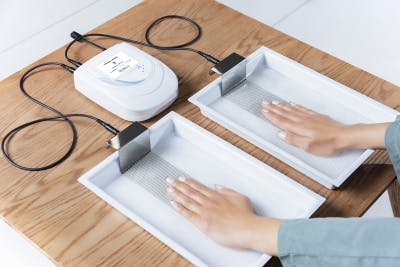Is there a link between spinal cord injury and sweating? The brain and body communicate through the spinal cord. However, after a spinal cord injury, that communication is disrupted, and messages may not be able to travel past the damage. As a result, functions like sweating may be affected.
This article will discuss why individuals with spinal cord injuries may experience excessive sweating and effective ways to manage it.
Spinal Cord Injury and Sweating
Sweating is the body’s way of cooling down. However, after a spinal cord injury, you may experience excessive sweating beyond what is required for thermoregulation (hyperhidrosis). Hyperhidrosis can exist on its own or be a symptom of autonomic dysreflexia.
Autonomic dysreflexia is a condition that can occur following a T6 or higher level spinal cord injury. It’s primarily characterized by a sudden spike in blood pressure when areas below the level of injury are stimulated.
Aside from high blood pressure, individuals experiencing autonomic dysreflexia may also experience:
- Increased sweating
- Flushed skin
- Feelings of panic or anxiety
- Chest tightness
- Headaches
Most commonly, individuals experience minimal to no sweating below their level of injury and excessive sweating above their level of injury.
The sweat glands are innervated by the sympathetic nervous system, which is controlled by a part of the brain called the hypothalamus. Because messages from the brain cannot reach areas below the level of injury, increased sweat secretion occurs above the level of injury,
Although more rare, it’s also possible for individuals to sweat exclusively below their level of injury.
Individuals with loss of sensation after SCI may not notice when areas below their level of injury are stimulated. Therefore, it’s essential to be aware of your surroundings, perform daily body inspections, and follow a bowel and bladder program.
In the following section, we’ll discuss whether there are any risks associated with abnormal sweating after SCI.
Is Excessive Sweating After Spinal Cord Injury Dangerous?
While excess sweating might not seem life-threatening, unmanaged hyperhidrosis can be uncomfortable and negatively affect one’s quality of life after spinal cord injury.
For example, excess moisture can be dangerous and contribute to the development of skin irritations like rashes, blisters, and pressure sores. It can also lead to inconveniences like having to bring extra clothes to change into, washing your sheets frequently, and constantly having to dry yourself off.
Additionally, hyperhidrosis can cause dehydration because your body is losing water at a faster rate than it is being replenished. Therefore, it’s essential to make sure you’re drinking enough water throughout the day.
Up next, we’ll discuss how individuals with hyperhidrosis can reduce sweating,
Treatments for Excessive Sweating After Spinal Cord Injury

There are a wide variety of treatments that can help you manage excessive sweating after spinal cord injury.
If excessive sweating is related to autonomic dysreflexia, it’s essential to identify what is triggering the reflex and remove it. For example, if your clothes are too tight, you can change into looser clothing and symptoms should subside. If symptoms persist, seek medical attention immediately.
If hyperhidrosis isn’t related to autonomic dysreflexia, other management interventions should be considered. Some common ways to address excessive sweating after SCI include:
- Iontophoresis. Iontophoresis involves using a device that sends low-voltage electrical currents to your hands or feet while they’re submerged in water. The electric currents stun the sweat glands, which results in temporarily reduced sweat secretion.
- Botox injections. Botox is a nerve blocker, meaning that it can prevent the sweat glands from receiving nerve impulses. The effects of Botox injections are temporary and typically last around 3-6 months.
- Medications. Topical creams or antiperspirants may be prescribed to keep the skin dry. Another option is to take a class of medications called anticholinergics. They block acetylcholine from binding to nerves, which can help reduce sweat secretions.
- Surgery. If all other treatments are ineffective, a sympathectomy may be performed. A sympathectomy is a minimally invasive procedure that involves cutting off a portion of the sympathetic nerve chain. Two tiny incisions are made under the armpit, and most patients can go home the same day with very minor or no side effects.
- Staying hydrated. As previously mentioned, excessive sweating can cause the body to lose water at a quicker rate. To prevent dehydration, individuals should make sure that they’re drinking enough water.
Depending on the severity of your SCI, some interventions may be more ideal than others. To determine an ideal treatment for you, speak with your doctor.
Understanding Increased Sweating After SCI
Excessive sweating above the level of injury is very common among spinal cord injury patients because the connection between the brain and body is disrupted.
While excessive sweating can be harmful to individuals with spinal cord injuries because of their limited mobility, there are many ways to effectively reduce sweating that can help improve your quality of life.
Now that you’re aware of what causes increased sweating after SCI and its effects, we recommend that you speak to your doctor about what treatments would work best for you.











